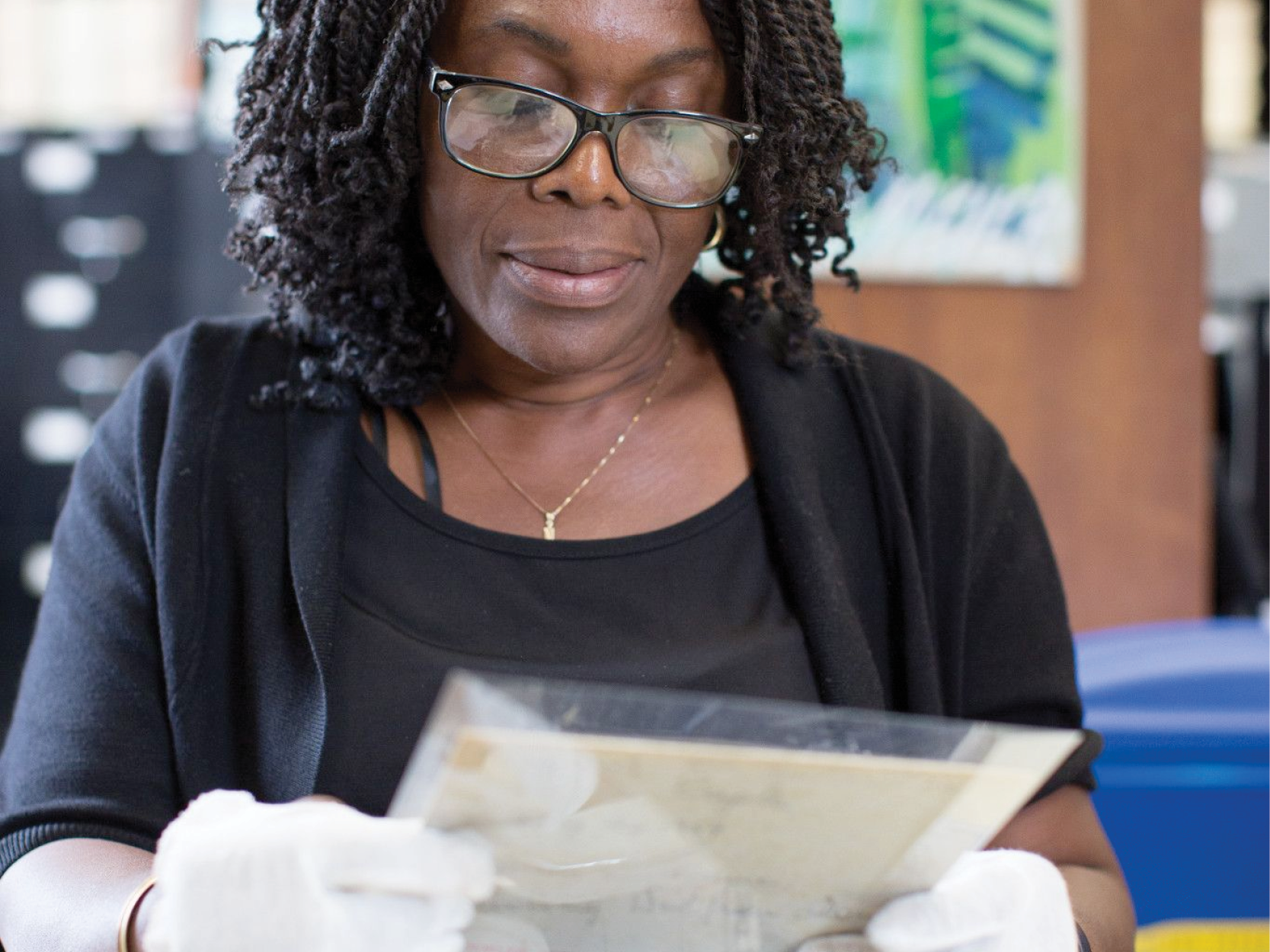Founded in 1841 by Isaac Van Anden and Henry Cruse Murphy, The Brooklyn Daily Eagle was published as a daily newspaper for 114 consecutive years without missing a single edition. The newspaper, originally conceived as a temporary political forum for the 1842 election, ironically lived the longest and absorbed all other Brooklyn daily papers except the Brooklyn Citizen. At one point the Eagle actually became the nation's most widely read afternoon newspaper. Unusual among major metropolitan daily newspapers of that time period, the Eagle chronicled national and international affairs as well as local news and daily life in Brooklyn. As a result The Brooklyn Daily Eagle provides a window into Brooklyn's past, as well as documentation of national and international events that shaped history.
The Eagle played a vital role in the community of Brooklyn's self-identification as separate and even better than Manhattan. Brooklyn existed as an independent city until the consolidation with New York City in 1898. Conceiving and promoting the building of the Brooklyn Bridge, the Eagle took an active role in developing the bridge as a symbol of Brooklyn's pride. The paper also coined the phrase describing Brooklyn as "the borough of homes and churches." With offices in Brooklyn, New York, Washington, Paris and London, the Eagle became one of the borough's greatest institutions.
Distinguished editors of the Eagle included Walt Whitman, Thomas Kinsella, St. Clair McKelway, Cleveland Rodgers, and Frank D. Schroth.
The rise and fall of the Eagle coincided with economic development in Brooklyn. The paper folded in 1955 after a prolonged strike called by the New York Newspaper Guild. At the time it closed it employed 681 people and did an annual business in the sum of approximately $6 million.
Through a partnership between Brooklyn Public Library and Newspapers.com, the entire run of the Eagle is available and keyword-searchable online.
Brooklyn and the Eagle Timeline
1646 Town of Breuckelen, as Brooklyn was originally spelled, was established by Dutch settlers. 1683 Kings County and six towns created: Brooklyn, Bushwick, Flatbush, Flatlands, Gravesend, and New Utrecht. 1816 Village of Brooklyn incorporated within Town of Brooklyn. 1827 Village of Williamsburgh incorporated within Town of Bushwick. 1834 Brooklyn officially became a city and eventually annexed the surrounding five towns of New Amersfoort (Flatlands), Midwout (Flatbush), New Utrecht, Boswick (Bushwick) and Gravesend to become the Brooklyn we know today. 1841 The Brooklyn Eagle was founded by Isaac van Anden. First named Brooklyn Eagle and Kings County Democrat, it started out as a morning paper that proclaimed its dedication to the Democratic belief in equal rights. The first issue was published October 26, 1841. 1842 Henry Cruse Murphy was elected mayor of Brooklyn, right after founding the Brooklyn Eagle along with Isaac Van Anden, April 12, 1842. 1846 Walt Whitman became Editor of the Eagle. He was fired after two years. 1848 First gas introduced to Brooklyn, March 27,1848. 1850 Samuel G. Arnold, Whitman's successor, reduced the name of the paper to The Brooklyn Daily Eagle. 1851 Arnold added steam power to the press, the first engine in the Brooklyn printing office. 1851 Village of Williamsburgh secedes from Town of Bushwick and becomes City of Williamsburgh. Kings County now includes two cities (Brooklyn and Williamsburgh) and five towns (Bushwick, Flatbush, Flatlands, Gravesend, and New Utrecht). 1852 Samuel G. Arnold was fired for supporting Henry Ward Beecher's sermons on sending rifles rather than Bibles to "bleeding" Kansas. He was replaced by Henry McCloskey, who had come to the paper as its first full-time reporter in 1851. 1852 Town of New Lots seceded from Town of Flatbush. 1853 Brooklyn City Railroad Co. incorporated, December 17, 1853. 1854 The cities of Brooklyn and Williamsburgh and Town of Bushwick, were consolidated into City of Brooklyn by legislature on April 17, 1854, taking effect January 1, 1855. 1855 The Board of Education of the Consolidated City of Brooklyn first met, January 21, 1855. 1859 Brooklyn Academy of Music was incorporated, January 19, 1859. 1859 Introduction of first piped water celebrated with fireworks at City Hall on April 28, 1859 (first water piped November 1858). 1861 Civil War broke out and as Brooklyn's attention was drawn into the conflict, the Eagle became more prosperous than ever. 1861 Grand Jury inquiry into whether several newspapers including the Brooklyn Daily and "Weekly" Eagle were guilty of disloyalty, encouraging the enemy, and urging that the North give in to the demands of the South. The Eagle, which had not been the Weekly Eagle for seven years, argued for freedom of speech. The paper was not indicted, but the postmaster general ordered its New York postmaster not to accept the newspapers for mailing. 1861 The mob visited The Brooklyn Daily Eagle and other newspapers to force them to show their loyalty to the Union by displaying the flag, April 17, 1861. 1861 Henry Ward Beecher, in rousing speech imitating a slave auctioneer, raised money from congregation to free a slave girl, Sarah, June 11, 1861. 1861-84 Thomas Kinsella was tenured editor at the Eagle. 1862 The first iron-clad warship, the Monitor, designed by John Ericsson, was launched at Greenpoint, January 30, 1862. 1863 Draft riots broke out in New York City, July 13, 1863.
1863 Raid on house at 653 East 4th Street reveals opium den, July 15, 1863. 1867 Work commenced on Brooklyn anchorage of Brooklyn Bridge, January 23, 1867. 1867 First public meeting of the Plymouth Temperance Society, addressed by Rev. Henry Ward Beecher, January 24, 1867. 1867 Inebriates Home for Kings County incorporated, May 9, 1867. 1867 With the addition of an eight-cylinder press, Kinsella enlarged the page size of the Brooklyn Daily Eagle. 1868 Brooklyn's Common Council authorized $3 million loan for construction of proposed East River Bridge, now Brooklyn Bridge, December 21, 1868. 1869 The Brooklyn Daily Eagle called Henry Ward Beecher "the Hercules of American Protestantism." 1869 Kinsella joined a distinguished group including Congressman Slocum, Hugh McLaughlin and seven consultants, for a six-day railroad tour of John Roebling's existing works and sent reports back to Eagle. The tour was arranged to promote Roebling's proposed suspension bridge over the East River; April 19, 1869. 1869 Eagle readers were not surprised to read headline, ROEBLING PLANS FULLY ENDORSED. The Eagle featured articles praising Roebling's proposed suspension bridge over the East River. 1869 John Augustus Roebling, engineer of the Brooklyn Bridge, died on July 22, 1869. 1870 Work on Brooklyn Bridge commenced with ground clearing, January 3, 1870. 1870 Brooklyn Daily Eagle protested disposal of dead cats, dogs, horses, goats, and cows in Brooklyn waters (Coney Island), July 27, 1870. 1871 Brooklyn foundation of Brooklyn Bridge completed, March 11, 1871. 1872 East New York voted 3-1 for annexation with Brooklyn, July 16, 1872. 1872 Construction on the Brooklyn Bridge continued, changing the shore line around the Fulton Ferry, July 29, 1872. 1872 Kinsella added another eight-cylinder press to The Brooklyn Daily Eagle. 1873 Brooklyn's new city charter passed by assembly, May 16, 1873. 1874 Brooklyn Elevated Railroad Co. incorporated, connecting Brooklyn and Woodhaven, Queens, May 26, 1874. 1874 Prospect Park was completed. Prospect Heights and Park Slope areas began to be developed. 1875 Beecher-Tilton trial opened, January 5, 1875. 1875 Isaac Van Anden, founder of The Brookyn Daily Eagle, died, August 4, 1875. 1876 Coney Island property owners protested the use of steam trains from Prospect Park to ocean to replace horse drawn carts, February 4, 1876. 1876 Brooklyn's Board of Education decided not to teach German and French in any schools because schools "should not serve interests of any class of people", February 4, 1876. 1876 Work began on the East New York end of the Brooklyn Elevated Railway, May 23, 1876. 1876 Brooklyn celebrated America's Centennial with parades; 20,000 people at Ft. Greene celebration; fireworks caused death and destruction, July 4, 1876. 1876 Over 300 people died in a fire that engulfed the Brooklyn Theater, December 5, 1876. 1878 Electric light first used in Brooklyn in Loeser's store on Fulton Street, December 14, 1878. 1880 Society of Old Brooklynites organized, April 29, 1880. 1883 Kinsella added two Hoe perfecting presses, which printed on two sides with folding attachments. 1883 Brooklyn Bridge was completed and opened. Designed by John Roebling, the bridge provided a crucial connection between Brooklyn and Manhattan and remains one of the city's architectural and engineering wonders. In a special edition, which broke all circulation records, the Eagle published a complete history of the Brooklyn Bridge project, "United! Brooklyn and New York by the Great Bridge, The Story of its Origin and Erection." The Eagle building, not far from the foot of the bridge, was decorated with a giant gas jet representation of an eagle, May 24, 1883. 1883 Memorial Day bridge tragedy. Fear of collapse caused panic and a stampede on the Brooklyn Bridge a week after opening, leaving 12 dead and 30 injured, May 30, 1883. 1883 Brooklyn Bridge trolley cars began public service, September 24, 1883. 1884 Kinsella died and Andrew McLean became editor. McLean was a thirty-six-year-old Scotsman who had worked his way to America in 1863 and had served on a iron-clad in the Navy till the end of the Civil War. 1886 St. Clair McKelway replaced Andrew McLean as editor. McKelway had been a correspondent for the New York World and the Eagle since 1868 and had written editorials for the Eagle from 1870 to 1878. He is known for his editorial genius during the period of the paper's period of greatest influence. 1886 Town of New Lots annexed into City of Brooklyn. Kings County was then the City of Brooklyn and four towns (Flatbush, Flatlands, Gravesend, and New Utrecht). 1887 Henry Ward Beecher died, March 8, 1887. 1888 New York Board of Education building construction began, January 17, 1888. 1888 American Baseball Convention held in Brooklyn, March 5, 1888. 1889 Bill introduced into legislature for tunnel connecting Brooklyn to New York, February 5, 1889. 1889 Hot dog introduced at Coney Island by Charles Feltman, July 23, 1889. 1889 Washington Bridge over the Harlem River opened April 28, 1889. 1890 Flatbush voted against annexation to Brooklyn, April 2, 1890. 1890 Electric cars began running to Coney Island, April 19, 1890. 1890 Last performance given at Brooklyn Theater, which was demolished for construction of the new Brooklyn Daily Eagle building, June 2, 1890. 1890 Seven-foot man-eating shark captured in Jamaica Bay, August 2, 1890. 1890 "Negro" citizens demand increase in educational facilities, October 6, 1890. 1890 Cornerstone of new Brooklyn Daily Eagle building, Johnson and Washington Streets, laid November 27, 1890. 1891 Wiley G. Overton appointed as first "colored" policeman in Brooklyn, March 5, 1891. 1892 Bill sent to Albany established public library in Brooklyn, February 24, 1892. 1892 Brooklyn Daily Eagle moved to its new building in downtown Brooklyn across from Borough Hall. 1893 The McKim, Mead and White plan for new Brooklyn Institute Museum (now Brooklyn Museum of Art), adopted May 19, 1893. 1893 Brooklyn Day featured at Chicago World's Fair, June 27, 1893. 1894 City of Brooklyn annexed Towns of Gravesend, Flatbush, and New Utrecht, April 27, 1894. 1894 New Lots annexation to Brooklyn; bill became law without governor's signature, May 13, 1894. 1894 Popular vote cast to consolidate City of Brooklyn with City of New York, October 6, 1894. 1896 Town of Flatlands annexed with City of Brooklyn. City of Brooklyn became all of Kings County. 1896 Free postal delivery began in suburban districts, including New Utrecht, Gravesend and Flatlands, May 1, 1896. 1896 Williamsburg Bridge construction began, November 10, 1896. 1897 The Brooklyn Daily Eagle remained the only paper opposed to consolidation on any terms. The Eagle saw Brooklyn's wealth as tied to the value of its real estate and thought that the land value could increase without the political union with Greater New York. For several days the Eagle ran a leader on its editorial page calling Brooklyn "a city of homes and churches" and New York "a city of Tammany Hall and crime government." 1897 Brooklyn was the fourth largest city in the United States. 1897-98 The borough of Brooklyn was consolidated into Greater New York City. This was known by many Brooklynites as the "great mistake." At the final meeting of Brooklyn's Common Council on December 31, 1897, one of the members aptly said, "And therefore, not farewell to Brooklyn, for Borough it may be, Brooklyn it is, Brooklyn it remains and Brooklynites we are." 1898 Pneumatic mail tubes under East River between Brooklyn and Manhattan formally opened, August 1, 1898. 1899 Special edition was published featuring Spanish-American war, January 1, 1899. 1900 A dozen skeletons, evidently of prison ship martyrs, dug up at the Navy Yard, January 23, 1900. 1900 Gov. Theodore Roosevelt signed a bill which changed the Brooklyn Public Library from an association to a corporation, April 10, 1900. 1901 Elevated trains began running over Brooklyn Bridge, January 21, 1901. 1901 Rapid Transit Commission adopted Brooklyn tunnel extension route from City Hall Park, Manhattan to Flatbush Avenue, Brooklyn, January 24, 1901. 1901 First connecting link of new East River Bridge (Williamsburg Bridge) towers completed, April 11, 1901. 1901 Sculptor Frederick W. MacMonnies group, "Spirit of the American Navy" placed on Soldiers and Sailors Memorial Arch at Prospect Park Plaza (now known as Grand Army Plaza), April 13, 1901. 1903 Williamsburg Bridge opened. 1909 Manhattan Bridge opened. 1913 Brooklyn Dodgers' stadium, Ebbets Field, opened. 1916 Dodgers won National League pennant, the first of nine before leaving Brooklyn. 1923 Martin H. Weyraugh, one of the Eagle's most scholarly and talented writers, published his own poem, "The Bridge Speaks," in which the Brooklyn Bridge argues against its own modernization. 1936 Brooklyn Times-Union bought by the Brooklyn Daily Eagle. 1938 The Brooklyn Daily Eagle changed its name to the Brooklyn Eagle, September 5, 1938. 1940 Frank Schroth and unidentified associates bought the Brooklyn Daily Eagle at a bankruptcy sale for approximately $400,000 in the name of the FDS Corporation of which he was president. 1941 Brooklyn Public Library Central Branch opened at Grand Army Plaza. Ground had first been broken for the project in 1912. 1941-55 The Eagle published special issues on the Brooklyn Bridge's anniversaries and fought for its modernization. 1947 Jackie Robinson, first black player in Major League Baseball, joined the Dodgers. 1950 Brooklyn's population peaked at 2,738,175. 1951 Ed Reid won Pulitzer Prize for his stories on the Harry Gross bookmaking scandal. 1952 Brooklyn Dodgers became National League champions. 1955 The Eagle closed following a protracted CIO American Newspaper Guild strike. Public sale of Brooklyn Daily Eagle with all of its assets of Good Will, Printing Facilities, etc. 1955 Dodgers won the World Series. 1957 Dodgers left Brooklyn for Los Angeles. 1957 Brooklyn Public Library gained possession of the Brooklyn Daily Eagle 'morgue' (clippings), files and records from Frank D. Schroth, the last publisher. 1960 Brooklyn Eagle returned as a Sunday newspaper and ended after a few issues. 1976 Former publisher, Bob Farrell sought to revive the Brooklyn Eagle. 1996 The name Brooklyn Daily Eagle was revived and continues to be used by a local community paper called "The Brooklyn Daily Eagle & Daily Bulletin", published Monday through Friday, since 1996 to the present.






